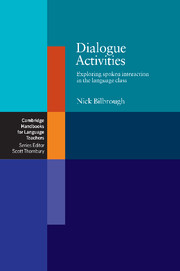Book contents
- Frontmatter
- Contents
- Thanks and acknowledgements
- Introduction
- 1 Understanding
- 2 Analysing
- 3 Reproducing and reconstructing
- 4 Memorising
- 5 Rehearsing and performing
- 6 Co-constructing
- 7 Creating and personalising
- 8 Communicating
- 9 Dialogue as learning
- Dialogue Bank A From the film Mulholland Drive
- Dialogue Bank B Authentic snippets
- Dialogue Bank C Snippets from fairy tales
- Dialogue Bank D Lame jokes
- Dialogue Bank E Situational dialogues
- Dialogue Bank F ‘Dating Agency’ from the comedy series Little Britain
- Further reading and resources
- Index
- Frontmatter
- Contents
- Thanks and acknowledgements
- Introduction
- 1 Understanding
- 2 Analysing
- 3 Reproducing and reconstructing
- 4 Memorising
- 5 Rehearsing and performing
- 6 Co-constructing
- 7 Creating and personalising
- 8 Communicating
- 9 Dialogue as learning
- Dialogue Bank A From the film Mulholland Drive
- Dialogue Bank B Authentic snippets
- Dialogue Bank C Snippets from fairy tales
- Dialogue Bank D Lame jokes
- Dialogue Bank E Situational dialogues
- Dialogue Bank F ‘Dating Agency’ from the comedy series Little Britain
- Further reading and resources
- Index
Summary
In the previous chapter dialogues were used mainly as a source of information and ideas. Here the focus shifts from an emphasis purely on meaning, to an examination of linguistic form. The activities included here challenge the students to notice aspects about the way messages are communicated in dialogues, rather than simply reacting to what is being communicated.
Tapescripts at the back of coursebooks are a useful resource which are often underexploited in the classroom. After doing the content-focused listening exercises in the coursebook, I have often found that asking the students to read the tapescript can raise awareness about language. Sometimes this can lead to a sudden realisation about what was actually being said and can clear up misunderstandings. In my experience many students appreciate these opportunities for close study of the form of spoken language, and this approach makes up for a general lack of such activities in some coursebooks.
Of course it is also useful for students to engage with more authentic dialogues which were not specially produced for language students. Also included here are activities which ask students to analyse the dialogue in poetry, television programmes and transcripts of authentic conversation.
The first four activities (Tricky words, Closed mouth minimal pairs, Fishermen and Stage directions (2.1–2.4)) aim to raise awareness about pronunciation features, and look at ways in which pronunciation affects meaning.
- Type
- Chapter
- Information
- Dialogue ActivitiesExploring Spoken Interaction in the Language Class, pp. 39 - 61Publisher: Cambridge University PressPrint publication year: 2007



